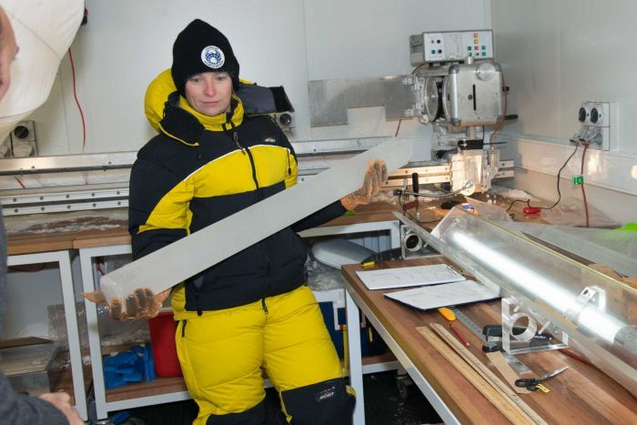 |
| A palaeoclimatologist inspects an ice core sample at the Institute of Marine and Antarctic Studies. (Supplied: Jill Brown/Australian Antarctic Division) |
The Million-Year Ice Core.
It sounds like the name of a Hollywood blockbuster starring a Hemsworth brother.But it is actually far cooler than that.
It's the "holy grail of climate science", a piece of ice so old that it might be able to reveal the climate of the past and help predict the future of Earth's atmosphere.
And Australia's Antarctic scientists are now part of an international race to find the ancient time capsule.
So, what is it?
Somewhere deep below the surface of Antarctica, ice has laid untouched for a million years or more — it's believed to be the world's oldest ice.
Scientists have spent years mapping the areas where they believe this ice may be and are now racing to identify the precise location and retrieve it.
 |
| Australia's Antarctic scientists are part of an international race to find the ancient time capsule. (ABC News: Jane Norman) |
Once they settle on a location, scientists will drill up to three kilometres into the Antarctic ice sheet and extract a long cylinder or "core" of ice to sample.
That cylinder is then sliced thinly and analysed, like the rings of a tree.
It's a difficult, expensive and lengthy process which is why Australian scientists aren't expected to start drilling for another few years.
What do ice cores tell us?
Scientists have been extracting ice cores from Antarctica for decades — the oldest is 800,000 years old.
When ice freezes, it traps tiny bubbles of air so these ice cores provide a detailed archive of what the Earth's atmosphere, temperature and carbon dioxide levels were like going back hundreds of thousands of years.
The idea is that by studying the past climate, scientists will able to make more accurate predictions about how it will change in the future.
For example, ice core research has proven that up until industrialisation, the Earth's temperature and carbon dioxide levels rose and fell in lockstep.
Search for world's oldest ice core continues in Antarctica (ABC News)
Why is it the Holy Grail of climate research?
While the 800,000 year ice core has revealed a lot about climate history, something strange happened about a million years ago; the cycle of ice ages slowed down.
Rather than happening every 40,000 years, they started happening every 100,000 years.
Scientists believe carbon dioxide played a role but the only way to prove that theory is by finding the oldest possible record of the Earth's atmosphere.
It's one of the major unanswered questions of climate change and it's hoped the Million-Year Ice Core will finally solve it.
Why are so many countries in the race?
They say science is the currency of influence in Antarctica so if Australia can play lead role in locating it, our stocks on the frozen continent will go up.
This is important because the politics of Antarctica are changing and Australia needs to maintain its credibility, and role as an Antarctic leader, by investing in projects like this one.
China has already started drilling at one spot but Australia thinks an area called Dome C shows far more promise.
When will we start?
Australia will start preliminary drilling this Summer and if all goes to plan, we will start drilling for the ice core around 2020.
So stay tuned.
 |
| An image of the Wilkins Ice Shelf in Antarctica on March 25, 2009. (British Antarctic Survey) |
- Million-year-old ice the 'holy grail' of climate research in Antarctica
- Antarctica research race on for million-year-old ice extraction
- Climate wildcard methane is spiking, global research finds
- Australia's power grid in need of multi-billion-dollar upgrade: report
- Australian cars dirtier than previously thought: research

No comments :
Post a Comment